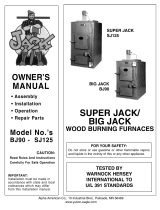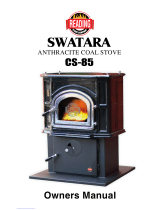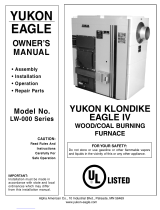
15
INSTALLATION
Please see all methods of Installation at the rear of
this booklet.
This is a furnace, not a free standing stove. You must direct
heated air from 8" outlets away from the furnace, or it will
not function properly.
1. This installation must be done by a qualifi ed heating
equipment installer.
2. The installation is to be done in compliance with National
Fire Protection Association installation standards: No.
89M, 90B, 211, 70 (National Electrical Code) and Uniform
Mechanical Code 913, 6-4, in the states where applicable.
(Their code offers connecting smoke pipe connectors
into chimney with other fuel burning appliances.)
3. Rooms large in comparison with size of the appliance:
a) Wood or Coal Burning Furnace needs air for combus-
tion and circulation to house.
b) Provision must be made to make up this air and not
starve gas or oil furnace of combustion air.
c) Have the "Authority Having Jurisdiction" determine
that air is of adequate makeup. (Reference N.F.P.A.
Nos. 30&54, Code for Installation of Gas & Oil Equip-
ment).
4. Have the "Authority Having Jurisdiction" to inspect all
chimneys and installations for adequate venting and for
compliance with standard and local codes and regula-
tions regarding installation of wood burning appliances.
5. Installation for Supplemental Heat Application to Existing
Central System.
a) Place Wood or Coal Burning Furnace so that the
chimney connector will be as short as practical and
avoiding unnecessary sharp turns in the smoke pipe
connector and the installation of devices that would
create excessive resistance to the fl ow of fl ue gases.
b) Locate the Wood or Coal Burning Furnace as close as
practical to the existing central hot air heating system,
maintaining clearances as stated on the label on the
fuel door.
c) Clearance from combustible materials must comply
with those stated on the label on the side of the unit.
Refer to the clearance table in the front of this manual.
The installation must be made only on a noncombustible fl oor.
d) Install the smoke pipe connector to the chimney
with 26-gauge pipe and elbows (to be purchased
separately), maintaining the proper clearances for the
specifi c model. Seal the smoke pipe in the chimney
with furnace cement. (The chimney connector shall
be securely supported, and joints fastened with sheet
metal screws or rivets.)
e) Install 8" diameter heat pipe to plenum of the central
hot air furnace. Use 26-gauge pipe and connectors (to
be purchased separately). If central air conditioning
is installed in the plenum, install heat pipe above the
air conditioning unit. Secure heat pipe connection
with supports and sheet metal screws.
f) Connect electrical supply in the electrical junction
box that is mounted on the back of the Furnace. See
Wiring Diagram (Fig. 16). Remove the cover from
electrical junction box and connect power supply wires
to wires designated, using wire nuts. The power cord
supplied may be used for installation, if permitted by
local codes and regulations. If the power cord sup-
plied cannot be used, the power supply wiring must
be 90 degrees centigrade in a metal cable and should
be completed by a qualifi ed installer complying with
NFPA Standard No. 70 and local codes.
POWER FAILURE
INSTRUCTIONS
Operation after loss of power:
1. Remove fi lter if provided
2. Do not expect to keep home at normal temperatures.
3. Do not load fuel above bottom of feed door.
The top down method of fi re building is recommended for this
appliance. After making sure that the stove air intake controls
are fully open (completely pull-out towards you), Place the
largest pieces of wood on the bottom, laid in parallel and
close together. Smaller pieces are placed in a second layer,
crossways to the fi rst. A third layer of still smaller pieces is
laid crossways to the second, this time with some spaces
between. Then a fourth layer of loose, small kindling and
twisted newspaper sheets tops off the pile.
Higher effi ciencies and lower emissions generally result
when burning air dried seasoned hardwoods, as compared
to softwoods or to green or freshly cut hardwoods.
DO NOT BURN:
1. Garbage;
2. Lawn clippings or yard waste;
3. Materials containing rubber, including tires;
4. Materials containing plastic;
5. Waste petroleum products, paints or paint thinners, or
asphalt products;
6. Materials containing asbestos;
7. Construction or demolition debris;
8. Railroad ties or pressure-treated wood;
9. Manure or animal remains;
10. Salt water driftwood or other previously salt water
saturated materials;
11. Unseasoned wood; or
12. Paper products, cardboard, plywood, or particleboard.
The prohibition against burning these materials does
not prohibit the use of fi re starters made from paper,
cardboard, saw dust, wax and similar substances for
the purpose of starting a fi re in an affected wood heater.
























